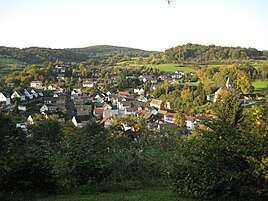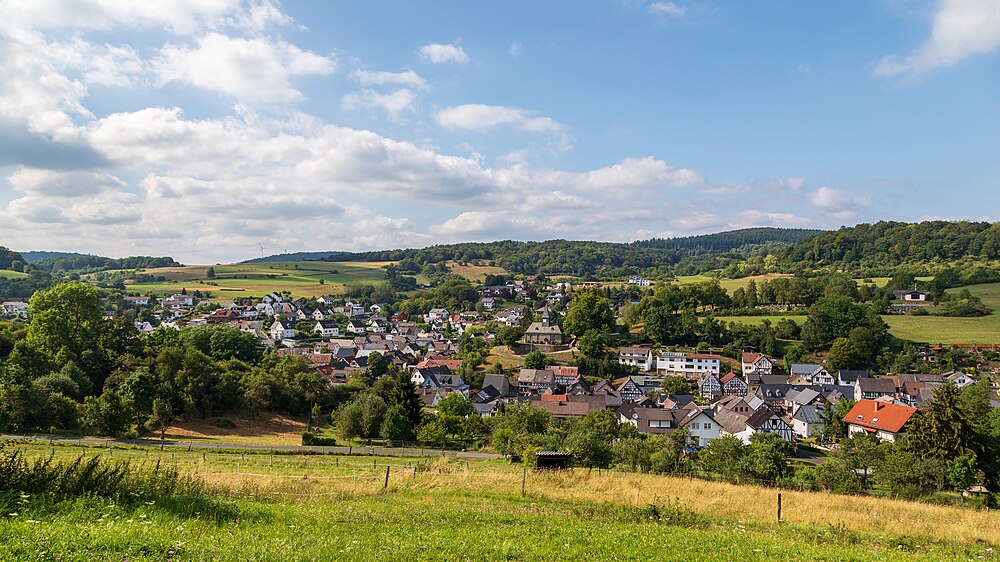Eibach (Dillenburg)
|
Eibach
City of Dillenburg
|
|
|---|---|
| Coordinates: 50 ° 44 ′ 51 ″ N , 8 ° 19 ′ 29 ″ E | |
| Height : | 290 m above sea level NHN |
| Area : | 8.53 km² |
| Residents : | 1130 (December 31, 2018) |
| Population density : | 132 inhabitants / km² |
| Incorporation : | 1st October 1971 |
| Postal code : | 35689 |
| Area code : | 02771 |
|
Eibach, view from the south
|
|
Eibach is a district of the Orange city of Dillenburg in the Lahn-Dill district in Central Hesse with around 1100 inhabitants.
geography
The place, characterized by the earlier mining, is located in the Scheldt Forest between the districts of Nanzenbach , Oberscheld and Niederscheld on the eponymous Eibach , a tributary of the Scheldt . Due to the existing healing spring , the water of which is very ferrous, the village is a popular place in the vicinity.
history
The history of Eibach begins with the "Nassau period" in the 13th century. In 1313 the village is mentioned for the first time in a document as "Ibach". It was one of originally three villages that were located in the three valleys around Eibach. The other two were almost completely wiped out by the plague and given up.
As in many places in the region, mining was also carried out around Eibach. In the Second World War , the village was spared major damage, in contrast to the neighboring towns of Niederscheld and Dillenburg , which were attacked several times by the Allies .
In the course of the regional reform in Hesse , the municipality of Eibach was incorporated into Dillenburg on October 1, 1971 on a voluntary basis . For the district of Eibach, as for the other incorporated, formerly independent municipalities, a local district with a local advisory board and local councilor was formed.
In 2004 the mineral spring was renewed and a graduation tower was built. On September 17, 2006, the village was hit by the worst flood in over 100 years. A low weather rained down completely in the Dillenburg area. The result was torrential rain with up to 103 l / m². The water was more than 50 cm high in places, so that many houses and cellars were flooded. Only three days later a family found 100 kg of the highly toxic substance arsenic from 1932 in a barn. The village was not spared from Hurricane Kyrill either; the forest was damaged in many places.
In 2007 a health trail was opened that leads to a treading pool and the graduation tower. In 2008 the village barn was inaugurated as a supplement to the village community center; the fountain in the center of the village and the surrounding streets have been renewed.
Territorial history and administration
The following list gives an overview of the territories in which Eibach was located and the administrative units to which it was subordinate:
- before 1739: Holy Roman Empire , County / Principality of Nassau-Dillenburg , Dillenburg office
- from 1739: Holy Roman Empire, County / Principality of Nassau-Diez , Dillenburg office
- 1806–1813: Grand Duchy of Berg , Department of Sieg , Canton of Dillenburg
- 1813–1815: Nassau-Orange
- from 1816: German Confederation , Duchy of Nassau , Dillenburg office
- from 1849: German Confederation, Duchy of Nassau, Herborn district office
- from 1854: German Confederation, Duchy of Nassau, Dillenburg Office
- from 1867: North German Confederation , Kingdom of Prussia , Province of Hessen-Nassau , Administrative Region of Wiesbaden , Dillkreis
- from 1871: German Empire , Kingdom of Prussia, Province of Hessen-Nassau, administrative district of Wiesbaden, Dillkreis
- from 1918: German Empire, Free State of Prussia , Province of Hessen-Nassau, Administrative Region of Wiesbaden, Dillkreis
- from 1932: German Empire, Free State of Prussia, Province of Hesse-Nassau, District of Wiesbaden, District of Dillenburg
- from 1933: German Reich, Free State of Prussia, Province of Hessen-Nassau, Administrative Region of Wiesbaden, Dillkreis
- from 1944: German Empire, Free State of Prussia, Nassau Province , Dill District
- from 1945: American occupation zone , Greater Hesse , Wiesbaden district, Dillkreis
- from 1949: Federal Republic of Germany , State of Hesse , Wiesbaden district, Dillkreis
- from 1968: Federal Republic of Germany, State of Hesse, administrative district Darmstadt , Dillkreis
- On October 1, 1971, Eibach was incorporated into the newly formed township of Dillenburg.
- from 1977: Federal Republic of Germany, State of Hesse, Darmstadt administrative district, Lahn-Dill district
- from 1981: Federal Republic of Germany, State of Hesse, Gießen administrative district , Lahn-Dill district
population
Population development
| Eibach: Population from 1834 to 2018 | ||||
|---|---|---|---|---|
| year | Residents | |||
| 1834 | 495 | |||
| 1840 | 508 | |||
| 1846 | 515 | |||
| 1852 | 505 | |||
| 1858 | 523 | |||
| 1864 | 551 | |||
| 1871 | 609 | |||
| 1875 | 543 | |||
| 1885 | 563 | |||
| 1895 | 591 | |||
| 1905 | 609 | |||
| 1910 | 612 | |||
| 1925 | 719 | |||
| 1939 | 748 | |||
| 1946 | 1,013 | |||
| 1950 | 994 | |||
| 1956 | 984 | |||
| 1961 | 1,043 | |||
| 1967 | 1,176 | |||
| 1970 | 1,229 | |||
| 1980 | ? | |||
| 1990 | ? | |||
| 1999 | 1,305 | |||
| 2005 | 1,259 | |||
| 2009 | 1,208 | |||
| 2014 | 1,148 | |||
| 2018 | 1,130 | |||
| Data source: Historical municipality register for Hesse: The population of the municipalities from 1834 to 1967. Wiesbaden: Hessisches Statistisches Landesamt, 1968. Further sources:; after 1970 city of Dillenburg | ||||
Religious affiliation
Source: Historical local dictionary
| • 1885: | 428 Protestant (= 76.02%), no Catholic and 135 (= 23.98%) other Christians |
| • 1961: | 804 Protestant (= 77.09%), 149 Catholic (= 14.29%) residents |
| • 2018: | 557 Protestant (= 49.29%), 132 Catholic (= 11.68%) 441 other residents |
politics
Local advisory board
The Eibach local advisory council consists of five members. After the local elections in Hesse in 2016 , it consists of three members of the CDU and two members of the SPD . The mayor is Matthias Weg (CDU).
coat of arms
The Eibach coat of arms shows hammer and mallet. This refers to the centuries-old mining tradition of the place.
Culture and sights
Regular events
- Every year in Easter time, the Eibacher village fountain is decorated as an Easter fountain.
- The maypole festival takes place at the beginning of May (also at the village fountain) . The highlight of this event is the erection of the maypole by the volunteer fire brigade.
- The small music festival Rocknacht takes place annually in summer.
Buildings
The graduation tower and the Eibach mineral spring are located before entering the town from the direction of Dillenburg and Niederscheld. Since 2007 there has been a health trail in Eibach , which leads from the healing spring to the treading pool at the mill. Another attraction is the village church, which existed before the Dillenburg church. It was already evangelical in 1533 and reformed in 1584.
traffic
From Dillenburg, the place is served by bus routes 150 ( Nanzenbach ) and 491 ( Oberscheld ). There are bike paths to Dillenburg , towards Niederscheld and Oberscheld . The former bus route 101 was discontinued at the beginning of 2013.
Individual evidence
- ↑ a b c d Eibach, Lahn-Dill district. Historical local dictionary for Hessen. (As of October 16, 2018). In: Landesgeschichtliches Informationssystem Hessen (LAGIS).
- ↑ a b c Population figures for the city of Dillenburg from the web archive: 1999 , 2005 , 2009 , 2014 , 2018
- ↑ Gerstenmeier, K.-H. (1977): Hessen. Municipalities and counties after the regional reform. A documentation. Melsungen. P. 288. DNB 770396321
- ↑ main statute. (PDF; 21; kB) §; 5. In: Website. City of Dillenburg, accessed February 2019 .
- ^ Michael Rademacher: German administrative history from the unification of the empire in 1871 to the reunification in 1990. State of Hesse. (Online material for the dissertation, Osnabrück 2006).
- ↑ Local Advisory Council Eibach. City of Dillenburg, accessed April 2019 .
Web links
- District Eibach on the website of the city of Dillenburg.
- Eibach, Lahn-Dill district. Historical local dictionary for Hessen. In: Landesgeschichtliches Informationssystem Hessen (LAGIS).
- Literature about Eibach in the Hessian Bibliography




